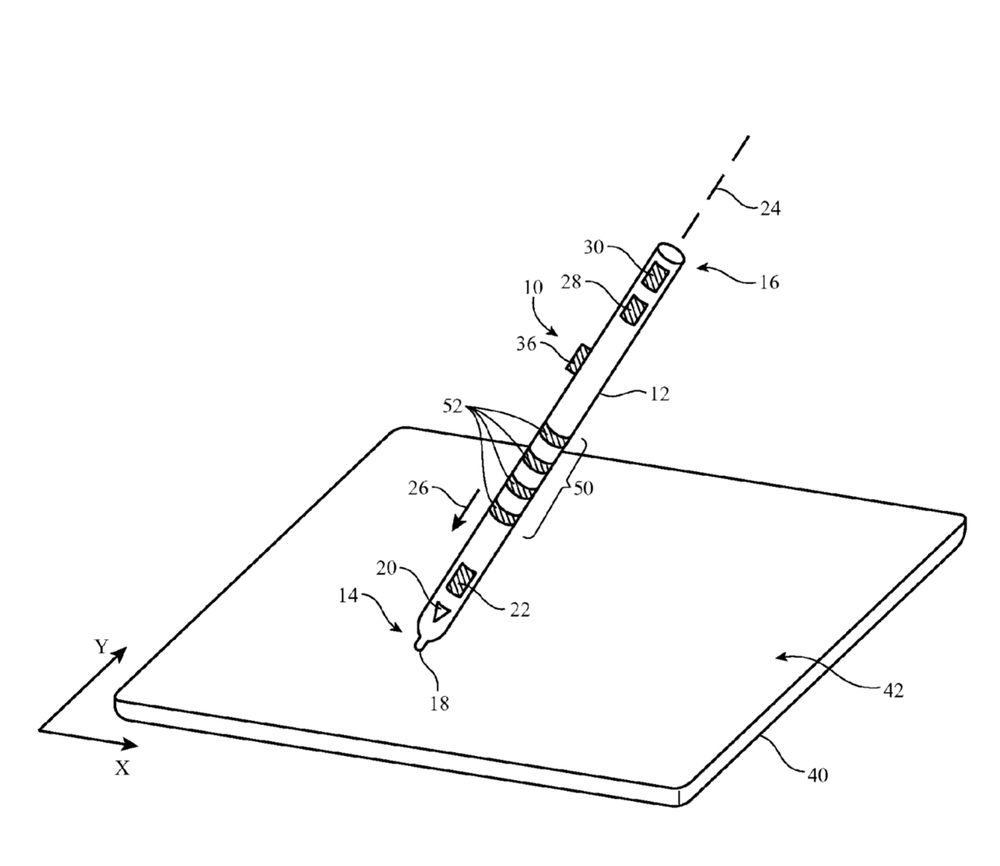Apple files for — and is granted — lots of patents by the U.S. Patent & Trademark Office. Many are for inventions that never see the light of day. However, you never can tell which ones will materialize in a real product, so here are today’s patent highlights:
Apple has applied for a patent (number 20160179222) that hints at a future versions of the Apple Pencil. It’s for a “stylus with touch sensor” (yep, Apple used the term “stylus”). Your finger’s location on the Apple Pencil would allow you to perform advanced device interactions. It would also support motion gestures such as running finer up or down the stylus to scroll.

The invention involves touch input that may include touch gestures in which a user’s fingers move along the length of the stylus and may include rotational information indicative of how the stylus is being rotated between the user’s fingers. The stylus may have a force sensor that monitors how firmly the stylus is being pressed against external surface and may have other input-output devices. The stylus may transition between operating modes based on signals from the force sensor and other input-output devices in the stylus.
Future iPhones, iPads, and Apple Watches may know if you’re right or left-handed. Apple has filed for a patent (number ) for “electronic devices with hand detection circuitry” that would allow gadgets with specialized sensors to detect whether a user’s right hand or left hand is being used to operate the touch-sensitive display.
Control circuitry may arrange icons and virtual buttons on the touch-sensitive display based on which hand is being used to provide touch input to the touch-sensitive display. For example, when the sensor circuitry detects a user operating the electronic device with his or her left hand, the control circuitry may position icons and virtual buttons closer to the left edge of the touch-sensitive display so that the icons and virtual buttons are easier to reach with the user’s left hand.

The sensor circuitry may include one or more touch sensors, proximity sensors, fingerprint sensors, motion sensors, or other suitable sensors capable of gathering information about which hand is being used to operate the electronic device.
Finally, Apple has been granted a patent (number 20160182507) for “wireless pairing and communication between devices using biometric data.” It involves technology that’s probably used in upcoming plans to allow you to unlock your Mac when you approach it wearing your Apple Watch. But the invention is also designed to make it easier to move/share files between all your Apple devices.
In the patent filing Apple says that, given the prevalence of electronic devices (such as desktop computers, mobile computing devices, portable data storage devices, smart phones, digital music players, and so on) that store data in the modern world, many users may own and/or utilize more than one such electronic device.
As such, users may need to wirelessly transfer data (such as music files, preference files, configuration files, document files, movie files, image files, and so on) back and/or forth between the storage media of various such electronic devices in order to make full use out of the electronic devices. In order to control the use of such electronic devices and/or the security of data stored by such electronic devices, electronic devices may need to perform one or more `pairing` operations before data transfer can be performed. However, in order to provide access control and/or security, such pairing processes may be time consuming and/or otherwise burdensome for users.

For example, electronic devices may be configured to pair and/or communicate data utilizing a Bluetooth communication connection. However, in order to configure the devices to pair and/or communicate utilizing the Bluetooth communication connection a user may be required to enter one or more passcodes into one or more of the electronic devices.
Apple says that such a manual configuration and/or passcodes entry system may be inconvenient for users. Users may not want to remember passcodes and/or have to enter such passcodes or similar security measures in order to transfer data between different electronic devices. Apple thinks it has a better solution.
